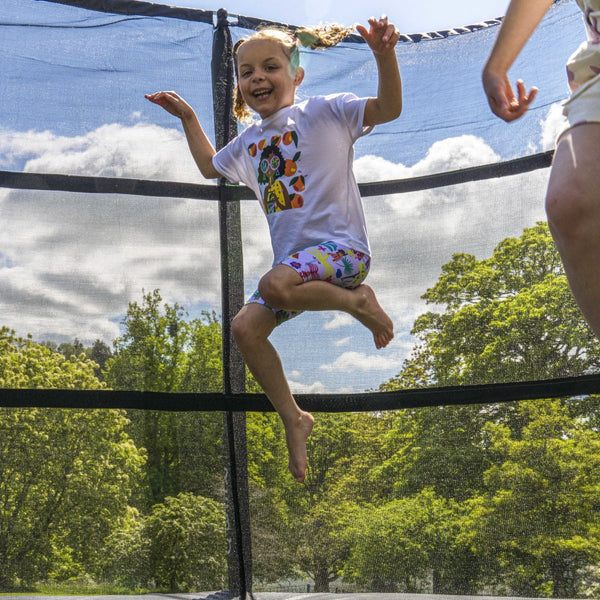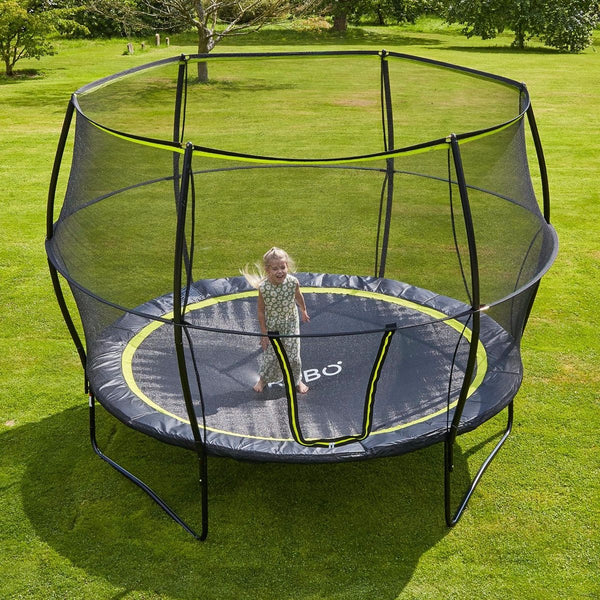Jumping for joy without a care in the world! Trampolines can be some of the best outdoor toys on the market. The simple yet stimulating pastime of jumping around in the garden holds a special place in the hearts of many.
With bucketfuls of bouncing fun, there are some safety considerations to bear in mind too. While trampoline injuries may occur, there are some straightforward practices to put in place to ensure your little one enjoys themselves as safely as possible.
Let’s bounce into action with our guide to trampoline safety.
The benefits of a trampoline
Before we spring a selection of ground rules on you, let’s discuss some of the perks. Trampolines were invented around 1934 and have kept families entertained ever since.
But there are a lot of benefits of trampolining beyond pure joy, such as:
- Fitness: Bouncing on a trampoline keeps your little ones moving. If you’re struggling to get them outside, take a look at our guide: How to encourage kids' physical activity.
- Socialisation: Depending on size, several people can usually fit on a trampoline. This makes it a social toy.
- Coordination: Jumping around and moving can help fine-tune a little one's coordination.
- New skills and hobbies: Trampolining is a proper sport, so playing on one could ignite a new hobby within your little jumper.
- Entertainment: Having a trampoline provides cheap, cheerful entertainment. On a loose end on a summer's day? Why not organise a trampolining tournament within the family?
Trampolines really are carefree and can be easily integrated into your back garden. If you’re concerned about the winter months, read our guide on how to store a trampoline in winter.

How to keep kids safe on a trampoline
Here, we'll go through some of the most effective trampoline safety tips so your family can get to the fun part as soon as possible.
Establish age ranges
Unfortunately, trampoline accidents can occur if young children are left unsupervised on the trampoline. For example, if you have a small child, you must ensure that full adult supervision is given on the trampoline at all times.
See it this way: it's an excellent opportunity to bond with your little one, making lasting memories of their first time on a trampoline!
Set a maximum capacity
Whilst every trampoline will have a different capacity, you should set clear ground rules regarding how many people can jump at one given time.
If it's a small trampoline, and you notice two people can't jump on it without trying hard to avoid bumping into each other, perhaps only one person should be allowed at a time.
No horseplay
Some of the most common trampoline injuries are ones where little ones get carried away playing. As a guardian, you should remind children that shoving, pushing or roughhousing while on the trampoline is foul play (and will result in cabbage soup for dinner!)
These are great environments to encourage the importance of kindness to your children, helping them develop empathy whilst they play.
Buy good equipment
A great trampoline will have great accessories to help keep a child safe.
When you're browsing trampolines, it's essential to look out for things such as:
- Safety pads or spring covers
- Tall, strong netting
- A sturdy trampoline ladder
To be safe, you can also purchase some foam safety mats to place around the base of the trampoline. While these aren't seen as standard in every trampoline package, they are a great addition for extra peace of mind.

Extra tips to keep kids safe on trampolines
Now we've covered the essentials, we'd like to leave you with some parting words of wisdom on how to keep your children safe on trampolines.
- First aid kits: Bumps and scrapes can happen, so it always pays to have a first aid kit on standby when the children are playing.
- Appropriate clothing: Encourage proper clothing when kids are jumping around! This could mean shoes off or no airy clothing that can get in the way. Think of it as exercise, and dress accordingly!
- No eating too soon before: Give your children an hour or so of rest after meals before they get on the trampoline. Jumping around could cause nausea if it's too soon after eating.
- No bouncing when tired: When a child is tired, their reaction speeds and ability to move suffer. To avoid bumps, scrapes or head and neck injuries, ensure they are fully rested when hopping onto the trampoline.
We'd like to stress that most trampoline injuries can be avoided. It's simply a case of having proper safety measures to ensure your children behave the way they should on the apparatus!
Fill your garden with joy from Outdoor Toys
Staying true to the theme of this blog: here at Outdoor Toys, our main focuses are enjoyment and safety. We ensure this by picking the best toys to feature in our range, made from durable, resistant materials that stand the test of time.
Is your child ready to jump in? Take a look at our range of trampolines.
If your little one isn't much of a jumper, they can climb into a brand-new playhouse or take a dip in their very own swimming pool or paddling pool with the help of Outdoor Toys.
FAQs
Are garden trampolines safe?
Backyard trampolines are perfectly safe, provided they are installed with the correct guidelines and accessories. In most cases, trampoline injuries occur thanks to neglect.
What are some features of a safe trampoline?
When looking at how to keep kids safe on a trampoline, the first thing you must look for in the buying stage is proper accessories. These can include good netting, safety pads, ladders and strong, well-reviewed materials.
While trampoline-related injuries can happen, they're easy to avoid with the right equipment and care.
Is it safe for a 2-year-old to jump on a trampoline?
Given the unpredictable nature of trampolines and the lack of body control a two-year-old has, someone of this age needs to receive full supervision from a guardian whilst playing on a trampoline.
This means the guardian should sit on the trampoline with the child, holding them if they lose their balance and keeping a close eye.


